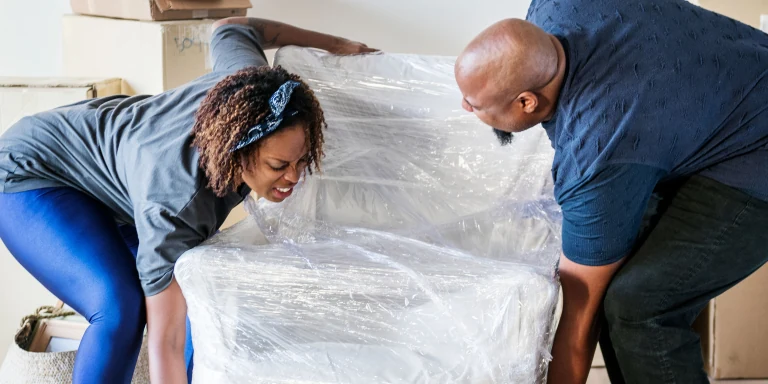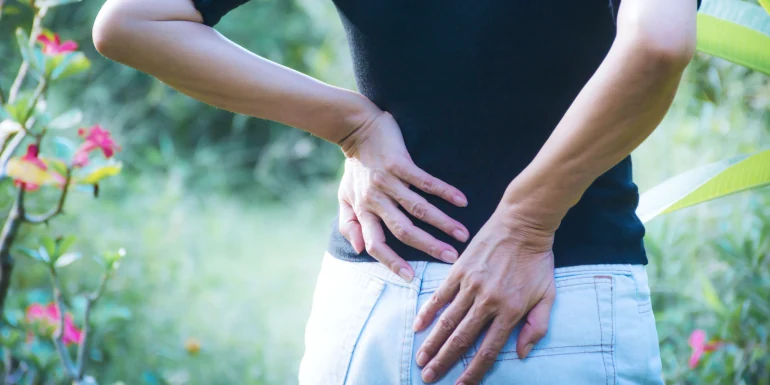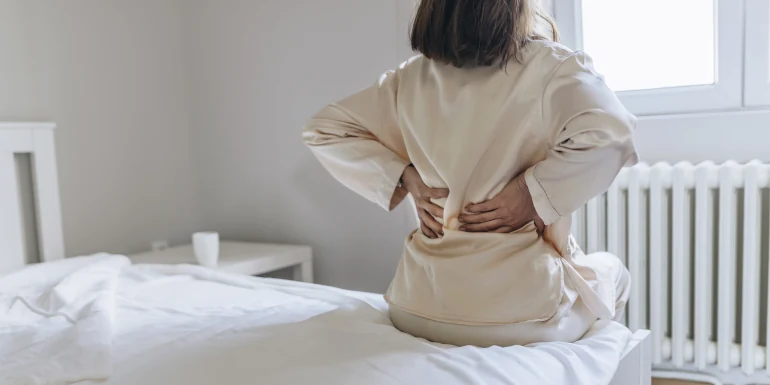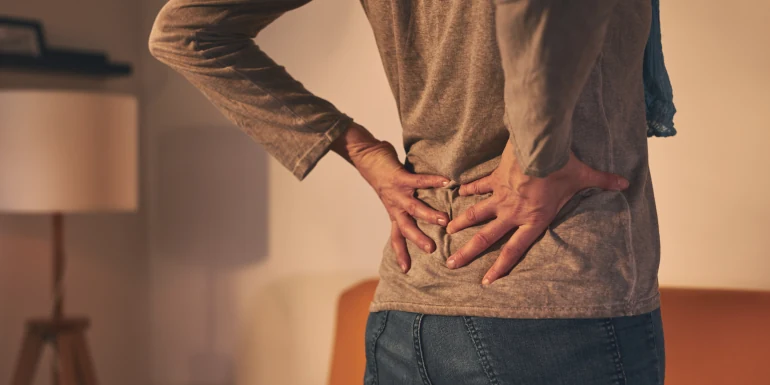
Lumbago – sudden-onset lower back pain
88% of the Swiss population experiences back pain at least once in their lives. Lumbago is especially painful and affects the lower back. Read more about triggers, causes and treatment options and how to prevent getting lumbago.
People suffering from lumbago walk around bent over like a witch. During the Middle Ages, people thought that supernatural beings were responsible for the pain. Two possible explanations as to why acute lower back pain is now called lumbago (Hexenschuss in German which literally means witch's shot).
What is lumbago?
Lumbago causes severe pain which occurs suddenly in the small of the back. It is often triggered by a sudden movement or strain. Also known as pain in the lumbar region.
Typical symptoms of lumbago
You feel strong pain in the small of the back. It is no longer possible to move. You instinctively adopt a relieving posture in order to avoid further pain. The pain becomes even more severe if you cough, sneeze or laugh.
Triggers and consequences of lumbago
Uncontrolled turning, bending, standing or lifting something heavy can be all it takes to trigger acute lumbago. One wrong move and the deep muscles of the spine cramp up. In order to prevent pain in the lower back, the brain reacts reflexively. The muscles tense up, so that we no longer move. It is one of the body’s protective mechanisms. As a result, the muscles tense up even more, too much strain is put on them and they become hardened. It is a vicious circle because this makes the back pain even worse.
The most common causes of lumbago are a blocked vertebra in the lumbar region, muscle tension or strain, and degenerative disc disease. Sudden-onset lumbago can be caused by vertebral flaring and protrusion. The pain results from the bulge which touches the nerve directly or from the resulting inflammation.
Lumbago can be a symptom of a herniated disc. In case of a herniated disk, neurological symptoms often occur: a tingling feeling in the leg or temporary paralysis of the leg muscles. Those affected find it difficult to stand on their toes or heels. A doctor can diagnose lumbago or a herniated disc. For example, he or she checks sensation in the lumbar vertebrae and legs, mobility and reflexes.
What should you do if you experience lumbago?
Alleviating the pain is top priority. Hot or cold compresses, pain killers, topical pain ointments or the so-called psoas position help. However, the important thing is to remain active in general. This prevents the muscles from tensing up even further and atrophying. Go on short walks. Alternate between lying, standing and sitting. After all, bed rest and a lack of exercise make the pain worse and delay treatment. There is even a risk of suffering another bout of lumbago.
Psoas position
The psoas position involves the head and back lying in a straight line on the floor. Put your knees and lower legs on a chair for 20 to 30 minutes, so that a right angle is created. This posture relaxes the sciatic nerve and the muscles in the lumbar vertebrae. However, the psoas position only alleviates pain for a short amount of time, so it is therefore used as an immediate measure.
Painkillers
Painkillers with the active ingredients ibuprofen, paracetamol or non-steroidal anti-inflammatory drugs (NSAIDs) also help to alleviate acute back pain. Due to the side effects and the risk of addiction, you need to consult your doctor about taking them.
Hot and cold compresses, massage
You can alleviate some of the pain by undergoing treatments which relax the muscles, such as a massage or the use of hot or cold compresses. Hot compresses can provide additional relief in case of strong pain. For instance, you can put a hot-water bottle on your back. Treatment with hot compresses expands the blood vessels and relieves tension. Cold compresses work better for some people affected. Use a cold pack and put it on the painful area.
Herbal remedies
In case of minor back pain, relief is provided by capsaicin, the main active agent of the chili pepper. Capsaicin is applied externally and is contained in plasters, for instance. You can use plasters in the spinal area to help alleviate the symptoms of muscle pain and tension. But beware: capsaicin can trigger allergic reactions. Other medicinal herbs like Devil’s Claw, frankincense, arnica, rosemary or St. John’s wort can provide additional pain relief. Devil's Claw has an anti-inflammatory effect and relieves pain. So does frankincense. Arnica also helps to reduce swelling. Rosemary promotes blood circulation and alleviates pain. Especially suitable for a hot bath. The red oil extracted from St. John’s wort can be used as an ointment for lumbago.
The pain should subside significantly after about three days. You should go to the doctor if your condition does not improve. It is important for the cause of the lumbago to be identified and rectified.
Our health consultation advisors will show you how you can relieve back pain. They’ll also give you tips on how to keep your back healthy in everyday life.
How can I prevent lumbago?
Regular and sufficient exercise is the be-all and end-all. Stretch and strengthen your muscles with regular sporting activities that do not put strain on your back. Sports like swimming, cycling or Nordic Walking are suitable for strengthening your back. And shed your excess weight. The heavier a person is, the more pressure is put on the spine.
Strong muscles thanks to Helsana Coach
Strengthen your back and stomach muscles or your torso and plan to take scheduled exercise breaks at work. In the Helsana Coach app, you will find numerous home training programmes.
Do you sit frequently? Pay attention to your posture. By adopting an incorrect posture in the workplace, we damage our muscles, ligaments, joints and intervertebral discs.
Exercise breaks with short workouts are just as important. Lifting loads correctly is also crucial. If you strain your body in a one-sided way, tension, neck pain or back pain are likely to occur. Stay active and relax in your daily life.
If you have ever suffered from lumbago, you should go to see a physiotherapist. In physiotherapy, your learn what exercises to do in order to strengthen your back muscles and how to do them correctly.

The specialist provided the editorial team with advice and input for this article. Evelyne Dürr (Msc in Human Movement Sciences, ETH; CAS workplace health promotion) was working for Helsana’s health consultation service at the time the article was written.



Newsletter
Find out more about current health issues every month and get all the information you need about our attractive offers from all Helsana Group companies * delivered by e-mail to read whenever it suits you. Our newsletter is free of charge and you can sign up here:
We did not receive your information. Please try again later.
* The Helsana Group comprises Helsana Insurance Company Ltd, Helsana Supplementary Insurances Ltd and Helsana Accidents Ltd.
